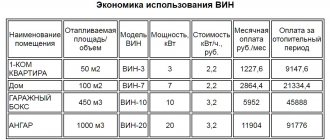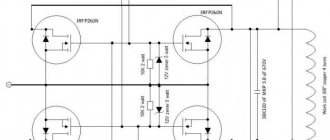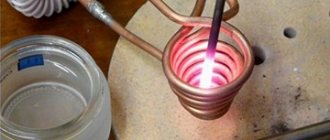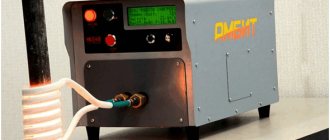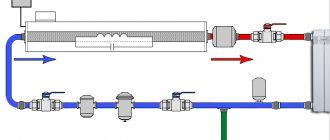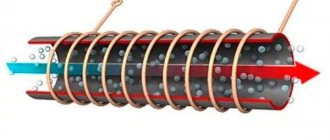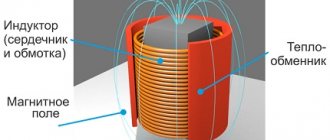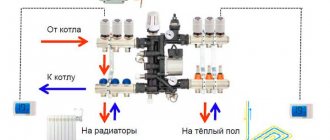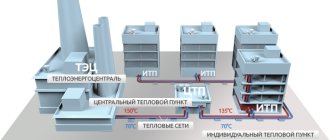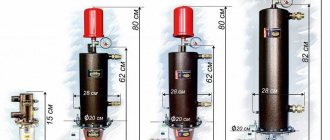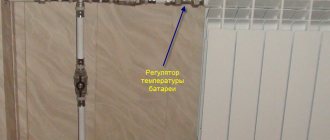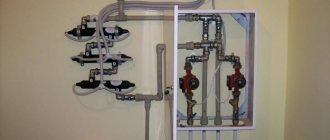In modern heating systems, more advanced equipment is used to minimize economic costs and increase the efficiency of installations. An induction boiler for a private home is an excellent alternative to classic models with heating elements.
The main advantage of induction boilers is the rapid heating of the coolant, so these models, in addition to heating, are used for heating water.
Principle of operation
The work is based on the principle of electromagnetic induction:
- After the device is started, an electromagnetic field is generated. In this case, the core warms up to a temperature of 75 degrees.
- Water is supplied through the inlet pipes to the core heat exchanger.
- The coolant heated to a given value is supplied to the pipe system through the outlet pipes.
For heating large and multi-storey buildings, the presence of a circulation pump in the system is mandatory.
Induction heating is the fastest of all currently available.
Models consist of three main nodes (layers):
- Internal - directly the core. Manufactured in the form of steel pipes.
- Insulation. Necessary to reduce heat loss to the unit.
- Outer – body. Made of metal.
The coolant used is water or antifreeze.
Advantages
- Economical. Compared to similar models, operating costs are 20% less. The efficiency of the induction unit is more than 97%, which is higher than that of classical models (due to the fact that heat loss for heating the induction coil is minimal). Electricity costs for heat production are significantly less than when burning coal or gas.
- Fast heating of the coolant.
- Durability. Subject to operating rules and regular technical inspections, induction boilers can last up to 40 years. Due to the absence of moving joints, there is no wear of parts. The use of copper increases the service life of the winding. In modern models, the core is made of reinforced materials that can operate in aggressive environments for several decades.
It is important to know! The service life depends on the quality of the transistors. Well-known brands offer a trouble-free operation guarantee of up to 10 years.
- No scale. Due to constant vibration, deposits cannot linger on the surface of devices even if the coolant is oversaturated with lime. There are always water bubbles on the core that repel scale particles.
- Compactness. The dimensions of induction boilers allow them to be installed in limited spaces. They do not require constant maintenance, a separate room and the construction of a chimney.
- Silence. Induction models do not create acoustic vibrations (circulation pumps make noise). Important! There are many circulation pumps whose operation does not create additional noise.
- Safety. To ensure correct operation and avoid emergency situations, RCDs and automatic circuit breakers are used, and special automatic shutdown devices are installed on boiler bodies.
- Fire safety. Unlike gas and solid fuel boilers, there is no open fire when operating induction boilers.
- Easy to install. With minimal skills in working with electrical appliances and handling, you can install the boiler yourself.
Myths about induction boilers
One of the most popular myths is created by sales representatives selling induction electric boilers. The bottom line is that these boilers are supposedly 20-30% more efficient than other heating electrical installations, especially heating elements. This information is not true, since all heat generators that convert electricity into heat operate with an efficiency of at least 96% in accordance with the physical law of conservation of energy. The only undeniable fact is that heating elements heat up the coolant a little longer due to their multilayer structure. The tungsten spiral first heats the quartz sand, then the tube material, and then the water. In this case, energy is not lost anywhere, and the efficiency of the heating element unit is 98%, the same as the vortex unit.
Example of a heating system
Another myth is that an induction electric boiler requires no maintenance at all, since the alternating magnetic field prevents deposits from settling on the heating elements. This question depends on the quality of the water and scale appears on the coil core in the same way as in heating element heaters if the coolant is not desalted. Therefore, at least once every 2 years, the heat generator itself and the heating system must undergo a flushing procedure.
Contrary to the assurances of the sellers, the water heater cannot be installed in any room. There are two reasons: the danger of electric shock and the presence of an electromagnetic field around the device. It is better to place it in a technical room with limited access (boiler room).
Boilers VIN
Designed for heating large private houses and cottages, garden and country houses, multi-storey buildings, industrial facilities.
A boiler with a vortex induction heater consists of the main components:
- Cylindrical heat exchanger.
- The primary coil is a large number of turns of wire, which is placed in a cylindrical housing.
- Magnetic cores.
- Inlet and outlet pipes.
- Terminal box required for connection to the electrical network.
- Control unit with thermostat.
It is important to know! The device is designed in such a way that there is no possibility of overheating of the internal elements of the system. The use of the compound allows metal surfaces to withstand temperatures up to 185 degrees.
Principle of operation
Cold coolant enters the unit through the lower pipe. After heating, the water is supplied to the heating system through the upper pipe. Temperature control is carried out using a thermostat and thermostat.
Due to its design, the unit always operates at maximum level. Therefore, to obtain an economic effect, it is necessary to use cyclic heating and connect coolant temperature sensors. After setting the required temperature mode, the automation turns off the induction heating when it reaches a critical point. After the coolant has cooled, the automation also turns on the boiler unit, creating a continuous heating cycle.
Important! The use of voltage regulation devices is irrational.
Single-phase VIN boilers are produced with low power, because... with increasing power, the current increases to 50 A, which requires the installation of new household electrical wiring with cables of large cross-sections.
To increase the power of a boiler unit with VIN, it is necessary to purchase and install additional water heating units or use a three-phase connection.
Important! When purchasing an induction boiler, you should also consider purchasing an uninterruptible power supply. For private homes, the best option is a transistor.
Installation diagram
Vortex Induction Heater "VIN"
Vortex Induction Heater “VIN” is reproduced according to the developments of N. Tesla. VIN is intended for use in autonomous heating systems, hot water supply in technological processes associated with heating the intermediate coolant. The absence of direct heating, unlike heating element and gas heaters, allows our products to work much longer (over 30 years) without losing their technical performance.
| Vortex induction heater "VIN" - 3 | Name of installation: "VIN" - 3 Installation power (kW): 3 Voltage, frequency (V/Hz): 220 / 50 Approximate heated volume (m3): 140 Amount of heat produced by the installation (kcal/hour): 2,527 Dimensions length, width, height (mm): 450*133 Weight (kg): 14 |
| Vortex induction heater “VIN” – 5 | Name of installation: "VIN" - 5 Installation power (kW): 5 Voltage, frequency (V/Hz): 220 / 50 Approximate heated volume (m3): 200 Amount of heat produced by the installation (kcal/hour): 4 210 Dimensions length, width, height (mm): 450*133 Weight (kg): 15 |
| Vortex induction heater "VIN" - 7 | Name of installation: "VIN" - 7 Installation power (kW): 7 Voltage, frequency (V/Hz): 220 / 50 Approximate heated volume (m3): 340 Amount of heat produced by the installation (kcal/hour): 5 900 Dimensions length, width, height (mm): 1200*133 Weight (kg): 38 |
| Vortex induction heater “VIN” – 10 | Name of installation: "VIN" - 10 Installation power (kW): 10 Voltage, frequency (V/Hz): 380 / 50 Approximate heated volume (m3): 480 Amount of heat produced by the installation (kcal/hour): 8,430 Dimensions length, width, height (mm): 1200*133 Weight (kg): 40 |
| Vortex induction heater “VIN” – 15 | Name of installation: "VIN" - 15 Installation power (kW): 15 Voltage, frequency (V/Hz): 380/ 50 Approximate heated volume (m3): 700 Amount of heat produced by the installation (kcal/hour): 12,640 Dimensions length, width, height (mm): 1200*133 Weight (kg): 52 |
| Vortex induction heater “VIN” – 20 | Name of installation: "VIN" - 20 Installation power (kW): 20 Voltage, frequency (V/Hz): 380/ 50 Approximate heated volume (m3): 950 Amount of heat produced by the installation (kcal/hour): 16,850 Dimensions length, width, height (mm): 1200*159 Weight (kg): 80 |
| Vortex induction heater “VIN” – 25 | Name of installation: "VIN" - 25 Installation power (kW): 25 Voltage, frequency (V/Hz): 380 / 50 Approximate heated volume (m3): 1100 Amount of heat produced by the installation (kcal/hour): 21,070 Dimensions length, width, height (mm): 1200*159 Weight (kg): 81 |
| Vortex induction heater “VIN” – 30 | Name of installation: "VIN" - 30 Installation power (kW): 30 Voltage, frequency (V/Hz): 380/ 50 Approximate heated volume (m3): 1400 Amount of heat produced by the installation (kcal/hour): 25 280 Dimensions length, width, height (mm): 1200*159 Weight (kg): 82 |
Prices for VIN products (323.77 kB)
| Share link to page: |
Induction boilers type SAV
They are used for autonomous and combined heating systems, hot water supply systems, backup heating sources, maintaining a given temperature in industrial installations (reactors).
The advantage of SAV boilers is the possibility of remote temperature control and complete automation of the heating process.
They consist of an inductor, a system of short-circuited channels and pipes and a heating element - a core. Heating of the coolant occurs due to the formation of an electromagnetic field and the conversion of electrical energy into thermal energy.
Important! Due to the branching of the installation system, the efficiency is approaching 100%.
Boiler units are produced in three types:
- Low-power. 2.5-10 kW. For small private and country houses.
- Medium power. 15-60kW. For administrative and multi-storey residential buildings.
- Great power. 100-500 kW. Used in industrial installations.
Operating principle of an induction heating boiler
Induction electric boilers are not as in demand as heating element or electrode boilers due to their high cost. In addition, the use of induction electric boilers for heating a private home is simply unjustified either from an economic or practical point of view. However, many intermediary sellers promote the equipment as an excellent option specifically for an individual heating system, which misleads many people.
Induction electric boilers do have some advantages, but they are not entirely significant in domestic operating conditions. Let's approach the choice of heating equipment wisely.
Read in the article
What are electric induction heating boilers?
Why are they needed and how are they used?
Induction electric boilers convert electrical energy into heat; they have been used for industrial purposes since the beginning of the 1990s. Relatively recently, they began to be promoted as economical and compact boiler units for individual heating systems in private homes, which is not entirely true.
The efficiency of almost all modern electric boilers is more than 99%, regardless of their type, which implies almost the same efficiency in converting electricity into heat. In addition, the automation, which really allows you to save money due to competent power control, in induction boilers is not outstanding and is inferior to heating elements, and sometimes even electrode ones.
In practice, the advantages in the form of compact size, greater reliability, higher heating rate of the coolant and easier maintenance are insignificant for domestic use and are justified only in the industrial sector, where large-capacity boiler systems are needed or certain technological processes require it.
In rare cases, induction heaters are justified in individual COs, where antifreeze is planned to be used as a coolant.
Design and principle of operation
An induction coil is placed in a compact metal case, inside of which there is a ferromagnetic core (metal pipe). On one side, cold water (return) is supplied to the core; on the other side, usually from above, the boiler supply is located.
The step-by-step principle of operation of an electric induction heating boiler looks like this:
- An alternating current (V or V depending on the power of the boiler) is supplied to the induction coil, as a result of which a magnetic field is formed around the coil.
- The magnetic field acts on the core through Foucault eddy currents and heats the core to a certain temperature (depending on the applied voltage)
- The heated core gives off heat to the coolant flowing through it.
Thus, the formation of scale on the core is almost impossible, especially with long-term use of filtered and softened coolant. Not only water can be used as a coolant, but also antifreeze, oil, and ethylene glycol-based coolants, which is often a significant criterion in the industrial sector.
Existing types
There are two types of induction electric boilers: standard induction (SAV) and vortex (VIN). The principle of operation of the former is described above; they all come with the SAV marking.
Vortex induction boilers (VIN) are more modern; they use an inverter that converts the standard alternating current frequency of 50 Hz into ultra-frequencies of 25 kHz and higher. In addition to the core, the coolant also washes the ferromagnetic body (which also heats up), which significantly increases the heating rate and makes it possible to reduce the size of the boiler unit while maintaining the same power. Due to a more complex design and more expensive body metal, vortex boilers are 1 times more expensive.
Should they be used for heating a private home: let’s look at known misconceptions
As we said earlier, the use of induction electric boilers is justified only in industry. However, it is worth confirming the words by analyzing all the known myths in more detail.
Efficiency and profitability
Despite sellers’ assurances of high efficiency, all modern electric boilers have about 99%. This means that, for example, at maximum load, a boiler producing 9 kW of thermal energy will consume 9. kW of electricity. However, over time, due to scale formation, the efficiency of heating element models decreases to 90 or even 80%, since more time and power are required to ensure the same heat transfer through the scale layer. In induction boilers, scale does not form and the efficiency remains unchanged.
But even in heating element models the problem can be almost completely solved:
- filtering the coolant being poured;
- installing softening filters;
- using the same coolant without draining it every season. Minerals will settle once on the heating elements and turn into an insignificant layer of scale, which practically does not affect the heating efficiency, after which they will simply have nowhere to come from.
In addition, in any case, you can always replace heating elements; they are inexpensive, and replacement is not difficult to do yourself. Savings can also be achieved by effective automation that controls the power of the electric boiler in accordance with needs, which is available in induction boilers, but is often inferior to heating elements or even electrode models.
We will deal with it later, but for now we can conclude that the efficiency of all modern electric boilers is the same, and the absence of scale is not worth an overpayment of more than 50%.
Reliability
Another frequent argument in favor of electric induction devices is their reliability: the design is as simple as possible, which means there is simply nothing to break in it.
This is true, but it applies to absolutely all high-quality electric boilers, since, unlike gas boilers, the only element that can fail under proper operating conditions is the heating element. But even with cleaned and soft coolant, they last for at least years.
Other elements in models from well-known manufacturers, such as a circulation pump, automation, a set of sensors or an air vent, according to practice, rarely fail during the first 10 years of operation.
Safety
Even with modern models, safety is not easy, since powerful inductive electric boilers create a serious load on the electrical network and distort the sine wave. It is necessary to connect the boiler unit only if the wiring is in excellent condition, preferably through a voltage stabilizer. In addition, the magnetic field is not isolated in any way, which can negatively affect the operation of nearby electronics.
Automatic and temperature control
An induction electric boiler is controlled using a separate control panel, which has fairly precise settings, but does not imply programming the operation of the boiler for the next day or week.
In well-known heating element models, the temperature is controlled more precisely: by degrees, thanks to a temperature sensor. In addition, in many models it is possible to install a room thermostat, which allows you to more efficiently and correctly regulate the operation of the boiler according to the temperature of the air in the room, and not the coolant at the outlet.
Weight and dimensions
The dimensions of induction boilers are really small, which allows you to install them almost anywhere in the house. However, this is not such a significant advantage over the already compact heating element models or extremely small electrode boilers, slightly larger than the main pipe.
The weight of induction heaters in most cases is 2 times more than heating elements models, within kg.
Reviews of induction electric boilers: advantages and disadvantages
Let’s summarize by analyzing all the real characteristics, installation practices and owner reviews:
| Advantages | Flaws |
| No scale formation process | High cost (% more expensive than heating elements or electrode models) |
| Compact dimensions | Mediocre automation and controls in the form of a control cabinet with step-by-step power adjustment |
| Coolant heating rate (on average 1.7 times higher) | It is not possible to organize control using a room thermostat |
| Reliability, breakdowns in the first years of operation of induction boilers of any power are rare | High load on the electrical network at home, curvature of the sinusoid, increasing the risk of voltage surges |
| Possibility of using oil, antifreeze or ethylene glycol-based coolant as a coolant | Unlike heating element models, a circulation pump, a safety group, and an expansion tank are rarely supplied with the boiler |
| It is worth remembering that heating a house using electricity in general is expensive. For a house with an area of 1 sq. m. this is about a thousand rubles. per month. |
Prices
Today the following manufacturers of induction electric boilers are known:
| Manufacturer | Cost, rub. (depending on power) |
| ZAVOD VIK | 28 |
| AntiGas | 35 |
| alternative energy | 33 |
